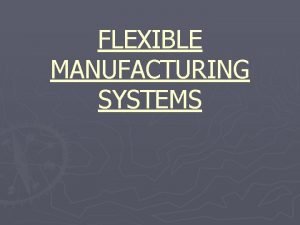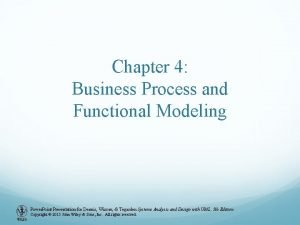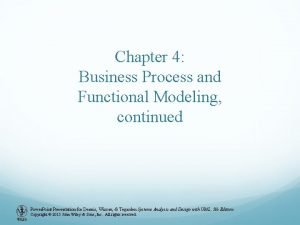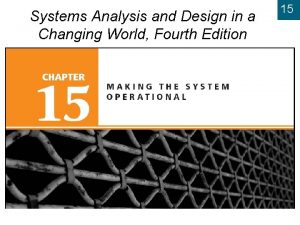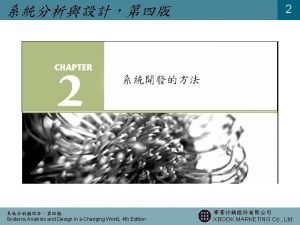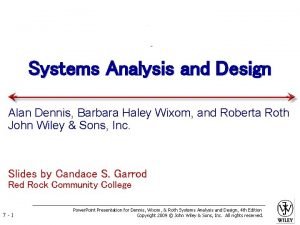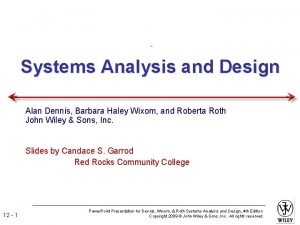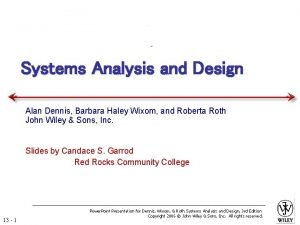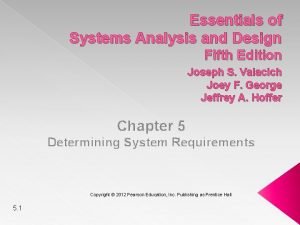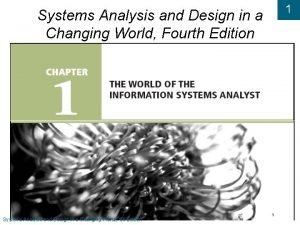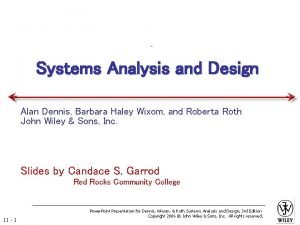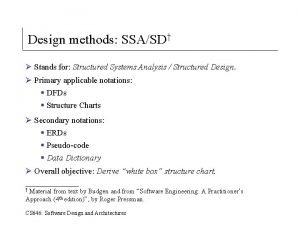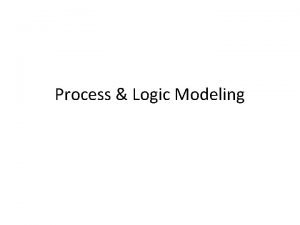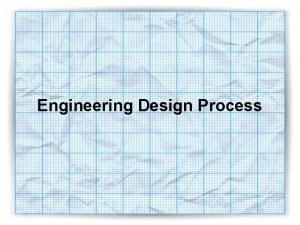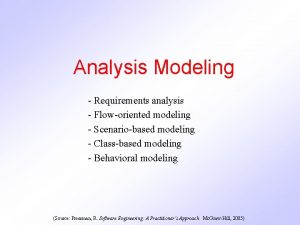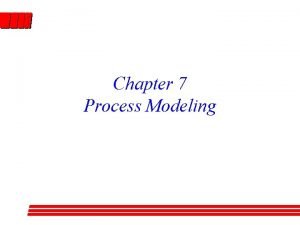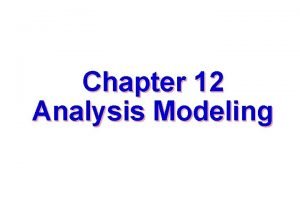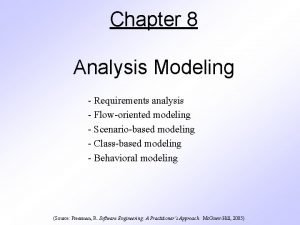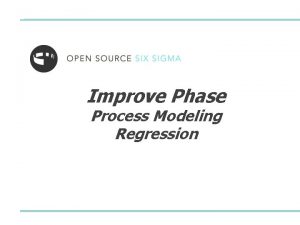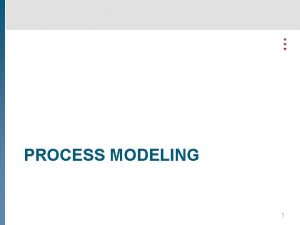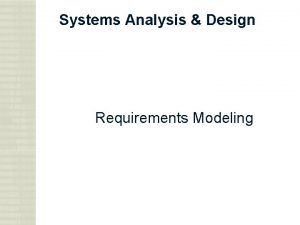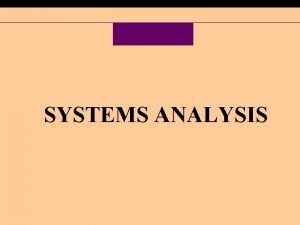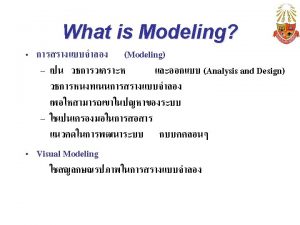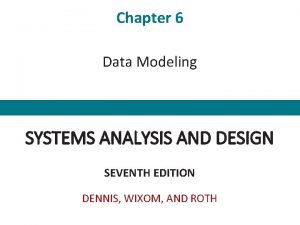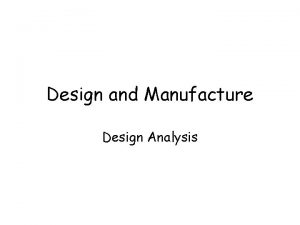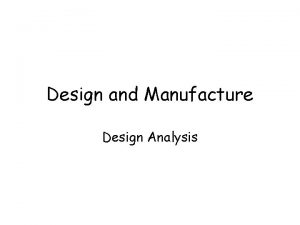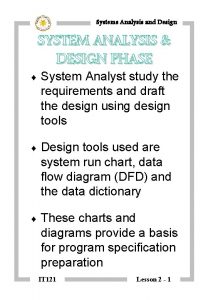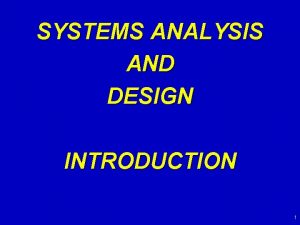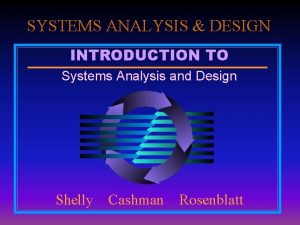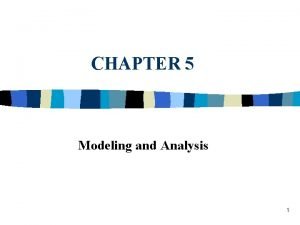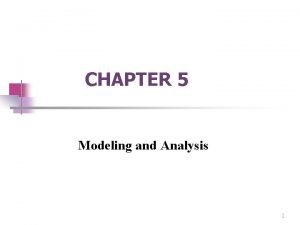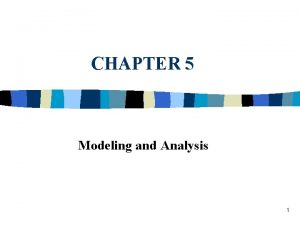Chapter 5 Process Modeling SYSTEMS ANALYSIS AND DESIGN











































- Slides: 43

Chapter 5 Process Modeling SYSTEMS ANALYSIS AND DESIGN SEVENTH EDITION DENNIS, WIXOM, AND ROTH

Learning Objectives • Explain the rules and style guidelines for data flow diagrams. • Describe the process used to create data flow diagrams. • Create data flow diagrams. Copyright © 2019 John Wiley & Sons, Inc. 2

Key Definitions • Process model A formal way of representing how a business process operates • Illustrate activities that are performed and how data moves between them • Logical process models describe processes without suggesting how they are conducted. • Physical process models include process implementation information • • Data flow diagramming • A popular technique for creating process models Copyright © 2019 John Wiley & Sons, Inc. 3

Data Flow Diagrams WHAT DO DFDS TELL US? Copyright © 2019 John Wiley & Sons, Inc. 4

Reading a Data Flow Diagram Copyright © 2019 John Wiley & Sons, Inc. 5

DFD Elements (1 of 7) • Process An activity or function performed for a specific business reason • Can be manual or computerized • Includes the following: • • A number • A name (verb phrase) • A description • At least one output data flow • At least one input data flow Copyright © 2019 John Wiley & Sons, Inc. 6

DFD Elements (2 of 7) • Process Logical process models omit any processes that simply move or route data and leave the data unchanged. • You do include logical processes that: • • Perform computations (e. g. , calculate grade point average) Make decisions (e. g. , determine availability of ordered products) Sort, filter or otherwise summarize data (e. g. , identify overdue invoices) Organize data into useful information (e. g. , generate a report or answer a question) Trigger other processes (e. g. , turn on the furnace or instruct a robot) Use stored data (create, read, update or delete a record) Copyright © 2019 John Wiley & Sons, Inc. 7

DFD Elements (3 of 7) • Data flow A single piece of data or a logical collection of data • Data Flow names describe the content of the data flow but not how it is implemented • Always starts or ends at a process • Includes the following: • • A name (noun) • Description • One or more connections to a process Copyright © 2019 John Wiley & Sons, Inc. 8

DFD Elements (4 of 7) • Data flow • A data flow is data in motion. • an input of data to a process, or the output of data (or information) from a process. • the creation, deletion, or update of data in a file or database (called a data store on the D FD). • A data flow is depicted as a solid-line with arrow. Control flows (non-data flows) trigger processes, such as ‘time to run the weekly payroll’ • The control flow is depicted as a dashed-line with arrow. • Copyright © 2019 John Wiley & Sons, Inc. 9

DFD Elements (5 of 7) • Data Store Most information systems capture data for later use. • A data store is a collection of data that is stored in some way • Include the following: • • • A number A name (noun) Description One or more input data flows (somewhere in process model) One or more output data flows (somewhere in process model) Copyright © 2019 John Wiley & Sons, Inc. 10

DFD Elements (6 of 7) • Data Store If data flows are data in motion, think of data stores as data at rest. • Data stores should describe “things” about which the business wants to store data. • Data flows leaving the data store are data retrievals • Data flows entering the data store are updates or new data added • Copyright © 2019 John Wiley & Sons, Inc. 11

DFD Elements (7 of 7) • External entity A person, organization, or system that is external to the system • Has interactions with the system (adds data to system or receives data from system) • Include the following: • • A name (noun) • Description Copyright © 2019 John Wiley & Sons, Inc. 12

Depicting Business Processes with DFDs • Business processes are too complex to be shown on a single DFD • A deliberate hierarchy is created with multiple “levels” of DFDs • To build the hierarchy, use Decomposition • Child diagrams show a portion of the parent diagram in greater detail Copyright © 2019 John Wiley & Sons, Inc. 13

DFD Hierarchy (1 of 3) • Context Diagram decomposes into Level 0 diagram Copyright © 2019 John Wiley & Sons, Inc. 14

DFD Hierarchy (2 of 3) • Processes on Level 0 diagram each decompose into separate Level 1 diagrams • Processes on Level 1 diagrams may or may not be decomposed into separate Level 2 diagrams. • Processes are decomposed until each process is a singlepurpose, primitive process. Copyright © 2019 John Wiley & Sons, Inc. 15

DFD Hierarchy (3 of 3) Copyright © 2019 John Wiley & Sons, Inc. 16

Balancing • Ensures that information presented at one level of a DFD is accurately represented in the next level DFD. • Data flows on parent diagram are carried down to child diagram. • Child diagram adds new processes and new data flows Copyright © 2019 John Wiley & Sons, Inc. 17

Context Diagram • Top-level DFD in every process model • Shows the context into which the business process fits • Shows the overall business process as just one process (process ‘zero’) • Shows all the external entities that receive information from or contribute information to the system Copyright © 2019 John Wiley & Sons, Inc. 18

Level 0 Diagram • Shows all the major processes that comprise the overall system – the internal components of process 0 • Shows how the major processes are interrelated by data flows • Shows external entities and the major processes with which they interact • Adds stored data via the data stores Copyright © 2019 John Wiley & Sons, Inc. 19

Level 1 Diagrams • Create one level 1 diagram for every major process on the level 0 diagram • Shows the internal processes that comprise a single process on the level 0 diagram • Shows how information moves to and from each of these processes • If a parent process is decomposed into, say, three child processes, then these three child processes wholly and completely make up the parent process Copyright © 2019 John Wiley & Sons, Inc. 20

Level 2 Diagrams • Shows all processes that comprise a single process on the level 1 diagram • Shows how information moves to and from each of these processes • Level 2 diagrams may not be needed for all level 1 processes • Correctly numbering each process helps the user understand where the process fits into the overall system Copyright © 2019 John Wiley & Sons, Inc. 21

Diagram Numbering • Correctly numbering each process helps the user understand where the process fits into the overall hierarchy Context Diagram is always “Process 0” • Level 0 processes are always numbered with integer value (1, 2, 3, etc. ) • Level 1 processes always have one “dot”: parent number “dot” unique number (1. 1, 1. 2, 1. 3, etc. ) • Level 2 processes always have two “dots”: parent number “dot” unique number (1. 1. 1, 1. 1. 2, 1. 1. 3, etc. ) • Copyright © 2019 John Wiley & Sons, Inc. 22

Alternative Data Flows • Where a process can produce different data flows given different conditions • We show both data flows and use the process description to explain why they are alternatives • Tip -- alternative data flows often accompany processes with IF statements Copyright © 2019 John Wiley & Sons, Inc. 23

Process Descriptions • Text-based process descriptions provide more information about the process than the DFD alone • CASE tools enable easy creation of descriptions • If the logic underlying the process is quite complex, more detail may be needed in the form of: • Structured English • Decision trees • Decision tables Copyright © 2019 John Wiley & Sons, Inc. 24

CASE Entry of Process Description Copyright © 2019 John Wiley & Sons, Inc. 25

Your Turn • At this point in the process it is easy to lose track of the “big picture”. • Describe the contribution of data flows, data stores, and processes to a process model. • Describe in your own words the relationship between the DFDs and the ultimate new application being developed. Copyright © 2019 John Wiley & Sons, Inc. 26

Creating Data Flow Diagrams HOW DFDS ARE DEVELOPED Copyright © 2019 John Wiley & Sons, Inc. 27

Steps in Building DFDs (1 of 2) • Build the context diagram • Identify the external entities and the major inflows they supply and the outflows they receive • Identify all major processes encompassed by the Context Diagram • Each major event / use case is “handled” by a process • Create DFD “fragments” for each event / use case • Each DFD fragment is a mini-diagram showing the process and the external entities and data stores with which it interacts. Copyright © 2019 John Wiley & Sons, Inc. 28

Steps in Building DFDs (2 of 2) • Organize DFD fragments into level 0 diagram • Decompose each level 0 process into a level 1 diagram; decompose level 1 processes into level 2 diagrams as needed; etc. • Validate DFDs with user to ensure completeness and correctness Copyright © 2019 John Wiley & Sons, Inc. 29

Integrating Use Cases • DFDs start with events, use cases and the requirements definition • The DFDs often flow directly from the use cases • Names of use cases become major processes on the Level 0 diagram • Steps in the use case become processes on the Level 1 diagram • Inputs and outputs become data flows on the Level 1 diagram (and below) Copyright © 2019 John Wiley & Sons, Inc. 30

Illustration – Developing DFDs (1 of 6) Creating the Context Diagram Copyright © 2019 John Wiley & Sons, Inc. 31

Illustration – Developing DFDs (2 of 6) Create a DFD “fragment” based on a use case Copyright © 2019 John Wiley & Sons, Inc. 32

Illustration – Developing DFDs (3 of 6) Merge DFD “fragment” diagrams into the Level 0 diagram Copyright © 2019 John Wiley & Sons, Inc. 33

Illustration – Developing DFDs (4 of 6) Develop Level 1 diagrams for every process on the Level 0 diagram • Level 1 – Process 3: Create Parts Request Copyright © 2019 John Wiley & Sons, Inc. 34

Illustration – Developing DFDs (5 of 6) Develop Level 1 diagrams for every process on the Level 0 diagram • Level 1 – Process 4: Record Receipt of Components Copyright © 2019 John Wiley & Sons, Inc. 35

Illustration – Developing DFDs (6 of 6) Develop Level 1 diagrams for every process on the Level 0 diagram • Level 1 – Process 5: Finalize Parts Request Copyright © 2019 John Wiley & Sons, Inc. 36

Evaluate DFDs for Quality (1 of 2) Syntax Within D FD Process • • Every process has a unique name that is an action-oriented verb phrase, a number, and a description. Every process has at least one input data flow. Every process has at least one output data flow. Output data flows usually have different names than input data flows because the process changes the input into a different output in some way. • There are between three and seven processes per D FD. Data Flow • • Data Store • Every data store has a unique name that is a noun, and a description. • Every data store has at least one input data flow (which means to add new data or change existing data in the data store) on some page of the process model. • Every data store has at least one output data flow (which means to read data from the data store) on some page of the process model. External Entity • Every external entity has a unique name that is a noun, and a description. • Every external entity has at least one input or output data flow. Every data flow has a unique name that is a noun, and a description. Every data flow connects to at least one process. Data flows only in one direction (no two-headed arrows). A minimum number of data flow lines cross. Copyright © 2019 John Wiley & Sons, Inc. 37

Evaluate DFDs for Quality (2 of 2) Across DFDs Context diagram • Every set of DFDs must have one context diagram. Viewpoint • There is a consistent viewpoint for the entire set of D FDs. Decomposition • Every process is wholly and completely described by the processes on its children DFDs. Balance • Every data flow, data store, and external entity on a higher level DFD is shown on the lower-level DFD that decomposes it. Semantics Appropriate Representation • • User validation Role-play processes Consistent Decomposition • Examine lowest-level DFDs Consistent Terminology • Examine names carefully Copyright © 2019 John Wiley & Sons, Inc. 38

Common DFD Errors • Syntax errors – violating “drawing” rules • Every data flow must connect to a process. • Every process must have at least one inflow and one outflow. • Semantics errors – errors in the meaning of the diagrams • Walk-through diagrams with users • Verify that inputs shown are logically sufficient to produce the outputs • Check for consistent levels of decomposition • Check for consistent use of terminology Copyright © 2019 John Wiley & Sons, Inc. 39

(cont’d) Common Syntax Errors © Copyright 2011 John Wiley & Sons, Inc. 5 -40

After reading and studying this chapter, you should be able to: (1 of 2) • Define the meaning and purpose of the four basic symbols found on a data flow diagram. • Explain the meaning and purpose of a process model’s context diagram. • Explain the meaning and purpose of a process model’s level 0 diagram. • Explain the meaning and purpose of a process model’s level 1 diagrams Copyright © 2019 John Wiley & Sons, Inc. 41

After reading and studying this chapter, you should be able to: (2 of 2) • Explain the concept of decomposition and why process models are created as a hierarchy of DFDs. • Describe several common syntax and semantic errors found on DFDs. • Discuss the process used to create a process model. • Discuss how the process model contributes to the development of the new information system. Copyright © 2019 John Wiley & Sons, Inc. 42

Copyright © 2019 John Wiley & Sons, Inc. All rights reserved. Reproduction or translation of this work beyond that permitted in Section 117 of the 1976 United States Act without the express written permission of the copyright owner is unlawful. Request for further information should be addressed to the Permissions Department, John Wiley & Sons, Inc. The purchaser may make back-up copies for his/her own use only and not for distribution or resale. The Publisher assumes no responsibility for errors, omissions, or damages, caused by the use of these programs or from the use of the information contained herein. Copyright © 2019 John Wiley & Sons, Inc. 43
 Process modeling in system analysis and design
Process modeling in system analysis and design Manufacturing systems modeling and analysis
Manufacturing systems modeling and analysis Model and role modeling theory
Model and role modeling theory System requirements checklist output example
System requirements checklist output example Relational vs dimensional data modeling
Relational vs dimensional data modeling Spontaneous generation in data flow diagram
Spontaneous generation in data flow diagram Typical process description tools include
Typical process description tools include When to use sdlc
When to use sdlc Business process and functional modeling
Business process and functional modeling Business process and functional modeling
Business process and functional modeling Systems analysis & design in an age of options
Systems analysis & design in an age of options System analysis and design
System analysis and design Systems analysis and design in a changing world
Systems analysis and design in a changing world Systems analysis and design in a changing world
Systems analysis and design in a changing world Systems analysis and design alan dennis
Systems analysis and design alan dennis Introduction to system analysis and design
Introduction to system analysis and design Ssadm stages
Ssadm stages Case tools are limited to systems analysis.
Case tools are limited to systems analysis. Modern systems analysis and design
Modern systems analysis and design Kendall & kendall systems analysis and design
Kendall & kendall systems analysis and design Alan dennis system analysis design
Alan dennis system analysis design Systems analysis and design alan dennis
Systems analysis and design alan dennis Systems analysis and design alan dennis
Systems analysis and design alan dennis Systems analysis and design alan dennis
Systems analysis and design alan dennis Systems analysis and design alan dennis
Systems analysis and design alan dennis Systems analysis and design alan dennis
Systems analysis and design alan dennis Systems analysis and design alan dennis
Systems analysis and design alan dennis Ssadm
Ssadm Radar range equation snr
Radar range equation snr Object-oriented systems analysis and design using uml
Object-oriented systems analysis and design using uml A modern approach to systems analysis and design
A modern approach to systems analysis and design Systems analysis and design kendall
Systems analysis and design kendall Systems analysis and design in a changing world
Systems analysis and design in a changing world Systems analysis and design in a changing world
Systems analysis and design in a changing world Systems analysis and design in a changing world
Systems analysis and design in a changing world Systems analysis and design alan dennis
Systems analysis and design alan dennis Systems analysis and design alan dennis
Systems analysis and design alan dennis Systems analysis and design alan dennis
Systems analysis and design alan dennis Modern systems analysis and design 7th edition
Modern systems analysis and design 7th edition Structured systems analysis and design method
Structured systems analysis and design method Essentials of systems analysis and design
Essentials of systems analysis and design Systems analysis and design in a changing world
Systems analysis and design in a changing world Systems analysis and design alan dennis
Systems analysis and design alan dennis List the five basic steps of ssa/sd process
List the five basic steps of ssa/sd process

